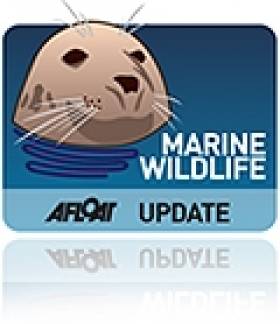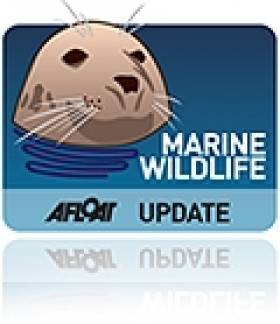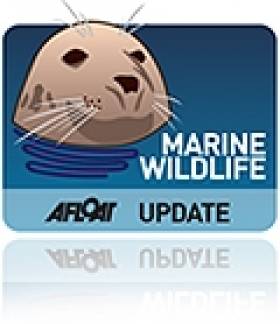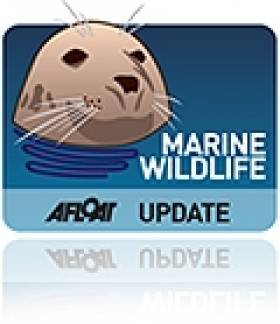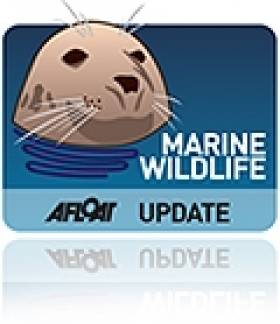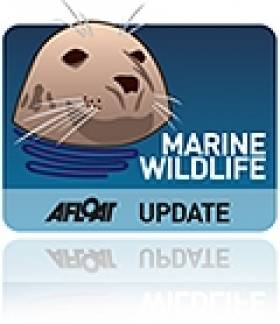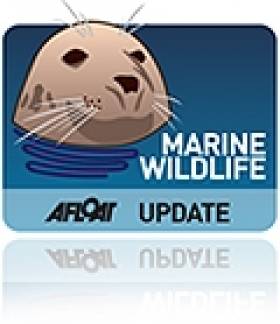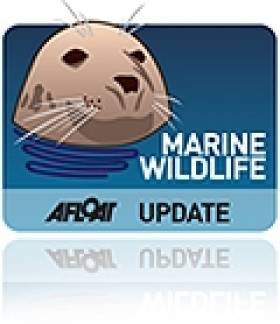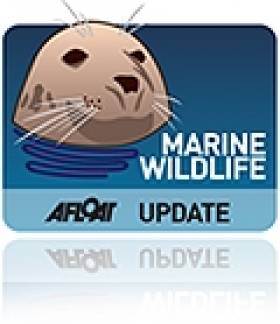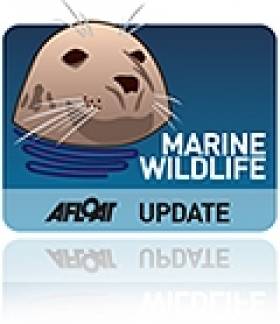Displaying items by tag: marine wildlife
'Unusual' Dolphin, Whale Strandings In Northwest
#MarineWildlife - Seven dolphins and two beaked whales have stranded on beaches in the northwest in events described as "unusual" by the Irish Whale and Dolphin Group (IWDG).
On the Mullet Peninsula, a group of seven common dolphins - comprising five adults and two juveniles - live stranded at Tarmon Beach on Sunday 12 May.
Though initial attempts to refloat them were successful, one of the juveniles was later found dead and the other was euthanised due to poor health.
Meanwhile in Donegal, the fresh carcass of a female True's or Sowerby's beaked whale was found on Sunday evening on Five Fingers Stand at Inishowen - some days after a reported live stranding of a Sowerby's beaked whale on the Welsh coast.
The Inishowen stranding was followed yesterday 14 May by the discovery of a dead beaked whale calf at Trawbreaga Bay, in what is believed to be a connected stranding.
Samples of the adult female were taken in order to confirm the species, either of which would mark a rare cetacean record for Ireland - the first since 2009.
#DolphinExhibition - Balbriggan Maritime Museum has opened a new public display in Balbriggan Tourist Office on Quay Street near Balbriggan Harbour.
On show is a Whale and Dolphin Exhibition, bones, models and general information to celebrate the biodiversity of sea mammals off the coast. This follows the previous popular 'Cannon Balls Exhibition'.
Appropriately, 'Water & Biodiversity' is the theme of the 2013 International Day for Biological Diversity which falls on Wednesday, 22nd May.
Balbriggan Maritime Museum volunteers have assembled bones from many sea animals, such as a vertebra from a Fin Whale, the second largest whale in the world growing to 88ft in length. No wonder this bone is too heavy for one person to lift!
The Humpback Whale model, in real life, is about half the length of a Fin Whale and weighs only 40 tonnes! Even so, Humpback Whales, which are seen in the Irish Sea, would be too big to fit into Balbriggan Courthouse!
Smaller skulls from Common Dolphin, Pilot Whale and Grey Seal, as well as a Minke Whale jawbone can also be examined during May when this Whale and Dolphin Exhibition will be on display from Tuesday to Sunday when the Balbriggan Tourist Office is open.
NI Marine Bill Progress Marks 'Turning Point'
#MarineWildlife - The Northern Ireland Environment Minister says the new Marine Bill put before Stormont marks a "turning point" for the North.
As 4NI reports, this week saw the fourth stage of the Marine Bill in the NI Assembly as well as the launch of a consultation strategy for Marine Protection Areas (MPAs).
Should it be enacted in legislation, the Marine Bill - strongly supported by the RSPB among others - would give the Assembly powers to select and manage Marine Conservation Zones (MCZs) to safeguard the North's marine biodiversity.
Minister Alex Attwood commented: "Northern Ireland’s seas are home to some of the world's most spectacular wildlife and habitats, and have the potential to power our nation through wind and wave and create thousands of new jobs.
"We have reached a turning point and must modernise in order to meet increasing and competing demands on our seas."
The Marine Bill also provides for the creation of a National Maritime Plan which covers all aspects of the marine environment from wildlife to investment in tidal and offshore wind power.
4NI has much more on the story HERE.
#MarineWildlife - The Irish Whale and Dolphin Group (IWDG) is marking 20 years of researching the dolphins of the Shannon Estuary.
As the IWDG's Dr Simon Berrow relates, it was not an auspicious start on 2 May 1993 when the first research trip on the estuary returned after five hours without having seen a single cetacean.
But the following day brought a bounty, with 16 dolphins across three different groups located by the IWDG - the beginning of two decades of sightings and recordings for the Shannon Dolphin Project, which has identified around 230 individual dolphins to date.
Thanks to that project, we know today that at least six of those dolphins first seen in 1993 are still in the estuary as of last year.
The Shannon Dolphin Project now has a website explaining its achievements and the work of the Shannon Dolphin and Wildlife Foundation (SDWF) over the years.
Meanwhile, Afloat reader Karl Grabe has also produced a spectrogram and edit of hydrophone recordings captured by Dr Berrow of Shannon dolphins just a few weeks ago.
Grabe previously uploaded a wonderful snippet of dolphins vocalising in the estuary late last year.
Dingle's Fungie May Have Come From British Dolphinarium
#Fungie - An Irish marine expert suspects that Dingle's most famous resident may be an escapee from a British dolphinarium.
Dingle Oceanworld director Kevin Flannery told the Irish Independent that Fungie the dolphin could have slipped through the sluice gates of any one of a number of dolphinariums on the south coast of England amid "huge objections to holding marine animals in captivity".
As previously reported on Afloat.ie, the male bottlenose dolphin appeared out of nowhere in Dingle's harbour in 1983 and has made his home there ever since.
In the three decades from then he has been credited with having "rescued" the village as his frolics brings countless tourists to the peninsula every year, as Flannery told the Irish Examiner.
This week's Féile na Bealtaine in Dingle celebrates the 30th anniversary of the arrival of the Kerry village's cetacean mascot, and many visitors are expected to line up for boat trips out of the harbour to meet him face to face.
While the Irish Whale and Dolphin Group (IWDG) doesn't recommend swimming with a wild dolphin such as Fungie, the group's Nick Massett describes him as "friendly, intelligent, and very aware of where people [are] in the water".
Among the festival activities this week will be a film screening and exhibits paying tribute to Ireland's own 'Flipper'.
Féile na Bealtaine runs from 2-6 May with events throughout the Dingle Peninsula.
#MarineWildlife - Marine scientists have joined conservation groups in a chorus of opposition to the British government's apparent backtracking on plans to protect marine wildlife in the seas around the UK - including between Britain and Ireland.
As The Guardian reports, 86 academics have written to UK Environment Minister Richard Beynon, Environment Secretary Owen Paterson and Prime Minister David Cameron, urging them to rethink the neutering of proposals for Marine Protection Zones (MPZs) around the United Kingdom.
Earlier this month, as reported on Afloat.ie, environmentalists expressed disappointment over Westminster's slow progress on the issue, coming after news that just 31 of a potential 127 sites would be designated as protected.
It has since emerged that even these 31 sites so not include full protection for wildlife from destructive fishing and dredging activities.
Prof Callum Roberts of the University of York told The Guardian: "We have seen spectacular devastation in the Irish sea in the last 20 years, for example, due to scallop dredging and prawn trawling.
"As fish stocks get ever more squeezed, the use of ever more destructive gear is spreading. This is happening now and protection is long overdue."
He added: "Even if all 31 MPZs were established, it will fall far short of what is needed to recover and safeguard English seas."
The Guardian has more on the story HERE.
Bunratty Dolphins Move On To Deeper Waters
#MarineWildlife - The trio of bottlenose dolphins who took up residence close to Bunratty Castle recently have apparently moved back out to deeper water after growing concerns for their well-being.
As previously reported on Afloat.ie, the dolphins had made their home opposite Durty Nellys pub in the Ratty River, which flows into the Shannon Estuary.
Simon Berrow of the Irish Whale and Dolphin Group (IWDG) explained that it's not unusual for dolphins to forage for food in waterways that feed into the estuary, though they usually return to the main catchment on their own shortly after.
With fears that their acoustic abilities were impaired, preventing them from navigating downstream past a series of bridges and concrete pillars between them and the main watercourse, a rescue attempt had been planned for late last week.
But as the Clare People reports, this was called off as the dolphins were spotted less and less frequently in the area.
Later hydrophone tracking by the IWDG led experts to discover that the cetaceans were able to come and go as they pleased.
Despite this, dolphins only have a limited ability to survive in fresh water, and can develop serious kidney and skin problems if exposed for a significant length of time.
Whale & Dolphin Group To Retrace Journalist's Whaling Voyage
#MarineWildlife - An upcoming research cruise by the Irish Whale and Dolphin Group (IWDG) is set to follow the path of a famous whaling voyage embarked on by an Irish Times journalist more than 100 years ago.
The paper reports on the pending mission by the marine wildlife charity's Celtic Mist research vessel that will retrace the movements of Crawford Hartnell from the site of what was then a Norwegian whaling station in the Inishkea Islands off the Mullet Peninsula in Mayo to a point 160km west where Hartnell report the harpooning of two whales.
Hartnell's accounts of his whaling adventure are remembered today for their blood-soaked vividness - but the IWDG's advances are altogether more friendly.
Rather than harpoon their quarry, the researchers on board the Celtic Mist will be on the lookout for baleen and beaked whales to count - and will also be teaching IWDG members how to identify species, how to carry out sea-bound surveys and how to use hydrophones to identify cetaceans by the sounds they make beneath the waves.
The Irish Times has much more on the story HERE.
Dolphin Trio At Home Near Famous Watering Hole
#MarineWildlife - Three bottlenose dolphins have made a new home close to a famous tourist watering hole in Co Clare.
According to the Irish Independent, the trio have taken up residence next to Durty Nellys pub in the Ratty River, which flows past Bunratty Castle into the Shannon Estuary.
The Irish Whale and Dolphin Group (IWDG), which has been tracking the group, believes they originated from a larger group populating the estuary.
As the IWDG's Simon Berrow explains, such dolphins are known to forage for food in rivers that feed into the estuary, and will return to the main catchment on their own.
While the risk of stranding in the shallower waters of rivers is unlikely, there is growing concern that the dolphins have been in the area for longer than expected.
"We can't rule out the possibility that their acoustic abilities may be impaired by the series of bridges and concrete pillars that span one of the bridges, and that they may be finding it difficult to navigate as a result of an 'acoustic trap'," says Berrow.
The IWDG says it is in discussion with the National Parks and Wildlife Service as to what options are available to step in to shepherd the trio back to the Shannon Estuary if necessary.
#MarineWildlife - UK environmentalists have expressed their disappointment at the British government's slow progress on developing its promised network of Marine Conservation Zones (MCZs), as the Belfast Telegraph reports.
The consultation period was for the proposals was set to end on Sunday 31 March - amid fears among conservation groups that were realised some months ago with the news that just 31 out of a potential 127 sites would be designated as protected for marine wildlife and plantlife by the end of this year.
It's being reported that Environment Minister Richard Beynon is blaming budget cuts and the high cost of scientific assessment for the slowdown in progress on the government's side.
"I want to do as many zones as we can for as little as we can," he told the BBC. "People have waited many years for this; we will designate the first tranche in September and will announce the next lot for consultation then."
The Royal Yachting Association (RYA) said in December that it was "encouraged" by the British government's "sensible" phased approach to the MCZ plans.
However, conservationists like Jolyon Chesworth from the Wildlife Trusts argue that their interests are being asked "to compromise on a compromise".
Chesworth added that the original 127 zones "were only nominated after very long discussions with anglers, sailors and the fishing industry".
The Belfast Telegraph has more on the story HERE.


























